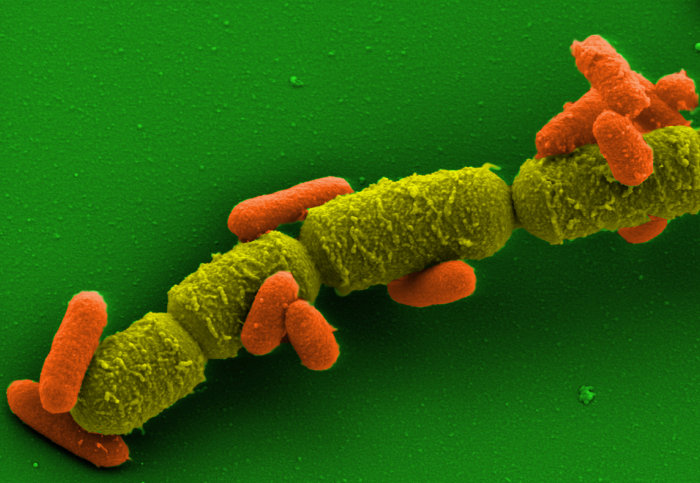Revealing the hidden biotech potential of unexplored organisms

Bacillus megaterium, also known as the “Big Beast”
Imperial researchers have developed a new, “cell-free” approach to investigating previously unexplored bacteria for biotechnology applications.
The research, published this week in PNAS, outlines an innovative new method that allows scientists to identify and analyse unusual organisms that could be tweaked for a range of different purposes – for instance, the development of new drugs and fuels – without using a single living cell.
Going cell-free
Although cell-free systems were first pioneered over a hundred years ago, their use in modern day synthetic biology research has only just begun to be established. Rather than relying on living organisms, scientists can cut and paste the parts of the cell that they need, and combine this with different DNA sequences to create bespoke biochemical pathways and proteins.
In recent years, cell-free biology has been used for a range of different purposes: medical viral biosensors, antibody production, and the engineering of microfluidic biochip devices. Now, for the first time, Imperial researchers have used this approach to study cell machinery and genetic parts in hitherto unchartered organisms.
Hidden treasures
Historically, the research community has relied upon number of “go-to” organisms that can be engineered for biotech purposes. For instance, E. coli, while normally living in our guts, is also an essential tool in modern biotechnology due to the fact that it is quick, easy and cheap to grow in labs. Scientists can then use E. coli as a host for DNA sequences from other organisms, and has aided the production of insulin and biofuels, among other things.
However, there are millions of other organisms with biotech potential that are more difficult to engineer and use in a laboratory environment. In this paper, researchers focussed on Bacillus megaterium, a giant soil microbe already used in the production of vitamins and amino acids, but still relatively unexplored.
A new approach: NCF and Bayes' theorem
The findings of the Imperial-led study offer a novel approach to quantitatively characterise and test DNA sequences in two key ways.
The cell-free system developed by the Imperial team – termed ‘native cell-free (NCF) transcription-translation’ – is the first of its kind. The semi-automated platform allows researchers to explore non-model organisms like B. megaterium without any direct genetic engineering – everything is performed in a test-tube using a technique called cell-free protein synthesis.
This approach is coupled with the first-time application of a statistical modelling technique based on Bayes’ theorem, which allows for a more accurate analysis of experimental data following the cell-free reaction.
The paper’s joint first author, Dr James MacDonald, explains: “A major part of this work is to accelerate our understanding using mathematical modelling and Bayesian parameter inference.”
“Most widely used statistical methods infer point estimates of parameters (i.e. the single best fitting set of parameters) which can give a misleading understanding of the system, especially when a large number correlated parameters are being simultaneously inferred.”
“Bayesian methods consider the model parameter themselves to be random variables with defined probability density functions and provides a way to rigorously update these probability distributions with each piece of extra information. As more experimental data becomes available, we improve our understanding of these parameter distributions and their probability density functions become narrower and better defined.”
“As part of this work, we have developed new open-source software to carry out the mathematical modelling and Bayesian parameter inference in order to make this computationally intensive analysis feasible.”
Beyond B. megaterium
As well as providing a better understanding of B. megaterium, the team’s NCF approach also paves the way for easier engineering of other poorly characterised organisms.
Joint first author Dr Simon Moore comments: “This work will rapidly improve our understanding of how we can potentially work with ‘non-model’ bacteria for biotechnology applications.”
“We’ll continue to investigate how new or "non-model" organisms can be engineered for future biotechnology applications, and how to improve our understanding of gene expression in other bacteria.”
Professor Paul Freemont, senior author and co-director of the UK’s Innovation and Knowledge Centre for Synthetic Biology at Imperial, said: “I am really excited about our work; it now provides a semi-automated framework that integrates mathematical modelling with experimentation for exploring new biotechnology applications using cell-free synthetic biology."
“Cell-free synthetic biology is a new and exciting field with so many potential applications, from paper-based sensors to distributed biomanufacturing of drugs, and having a robust engineering framework to explore exciting new organisms will accelerate these applications.”
'Rapid acquisition and model-based analysis of cell-free transcription–translation reactions from nonmodel bacteria' by Simon J. Moore, James T. MacDonald, et al., is published in the Proceedings of the National Academy of Sciences of the United States of America.
Image credit: Manfred Rohde, HZI, Germany, 2007
Article supporters
Article text (excluding photos or graphics) © Imperial College London.
Photos and graphics subject to third party copyright used with permission or © Imperial College London.
Reporter
Ms Genevieve Timmins
Academic Services